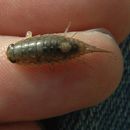Habitat
provided by Invertebrates of the Salish Sea
Rock crevices or under stranded Macrocystis algae in the high intertidal during high tides; ranges through intertidal at evening, especially at low tide.
- license
- cc-by-nc-sa
- copyright
- Rosario Beach Marine Laboratory
Distribution
provided by Invertebrates of the Salish Sea
Geographical Range: Sonoma County, CA to Central America.
- license
- cc-by-nc-sa
- copyright
- Rosario Beach Marine Laboratory
Habitat
provided by Invertebrates of the Salish Sea
Depth Range: Intertidal
- license
- cc-by-nc-sa
- copyright
- Rosario Beach Marine Laboratory
Comprehensive Description
provided by Invertebrates of the Salish Sea
This isopod is a member of suborder Oniscoidea. Flagellum of antenna 2 is much larger, with more than 10 articles when mature. Up to 2.5 cm long. Eyes separated by one full eye diameter. Uropods are nearly half as long as the body, with basal segments several times as long as broad.
- license
- cc-by-nc-sa
- copyright
- Rosario Beach Marine Laboratory
Look Alikes
provided by Invertebrates of the Salish Sea
How to Distinguish from Similar Species: Does not get as large as Ligia pallasii, plus the very long uropods are nearly half as long as the body, while in L. pallassi they are much shorter.
- license
- cc-by-nc-sa
- copyright
- Rosario Beach Marine Laboratory
Comprehensive Description
provided by Invertebrates of the Salish Sea
Biology/Natural History: Hides most of the day in crevices or under stones just above the high tide line. At night and at low tides in cool weather, forages throughout the intertidal zone. Is a scavenger, plus feeds on microscopic algae. This species is nearly terrestrial--it must keep its gills moist but will drown if forced to stay underwater. This species is very tolerant to water loss. They are paler at night than during the day due to clustering and dispersal of chromatophores. Animals on dark backgrounds remain darker than do those on light backgrounds. Ovigerous females have been observed at Monterey Bay in March, May, and June.
- license
- cc-by-nc-sa
- copyright
- Rosario Beach Marine Laboratory
Ligia occidentalis
provided by wikipedia EN
Ligia occidentalis is a species of rock slater in the family Ligiidae. L. occidentalis is a habitat generalist of rocky shores. It is found in North America and Mexico. The western sea slater (sometimes called the rock louse) is separated from L. pallasi by its much longer uropods and its larger eyes, set closer together along with its sleeker body. This species has a tendency to bolt when disturbed. These sea slaters hide in rocky crevices above the high tide line during the day. It may emerge at night or in cooler weather to scavenge for algae and detritus along beaches or rocky cliffs. Western sea slaters must keep their gills moist in order to breathe but they cannot survive long underwater and will drown.[1][2][3]
References

- license
- cc-by-sa-3.0
- copyright
- Wikipedia authors and editors
Ligia occidentalis: Brief Summary
provided by wikipedia EN
Ligia occidentalis is a species of rock slater in the family Ligiidae. L. occidentalis is a habitat generalist of rocky shores. It is found in North America and Mexico. The western sea slater (sometimes called the rock louse) is separated from L. pallasi by its much longer uropods and its larger eyes, set closer together along with its sleeker body. This species has a tendency to bolt when disturbed. These sea slaters hide in rocky crevices above the high tide line during the day. It may emerge at night or in cooler weather to scavenge for algae and detritus along beaches or rocky cliffs. Western sea slaters must keep their gills moist in order to breathe but they cannot survive long underwater and will drown.
- license
- cc-by-sa-3.0
- copyright
- Wikipedia authors and editors

